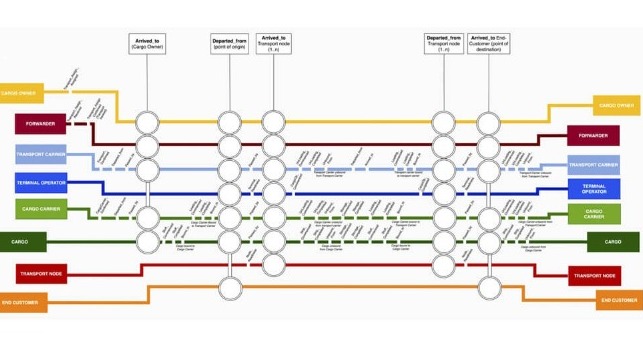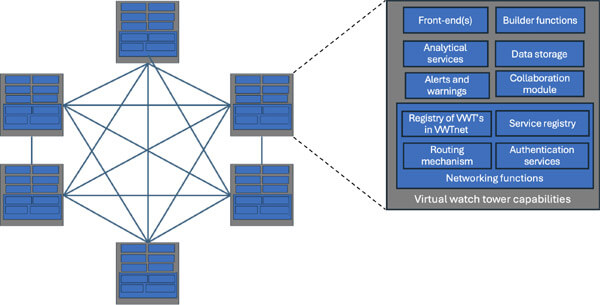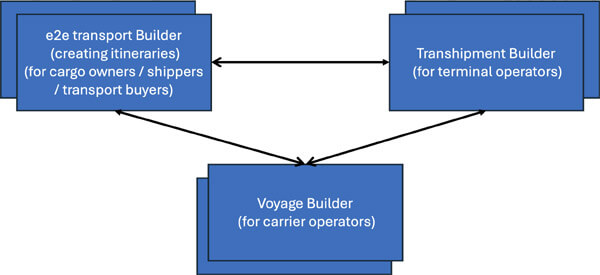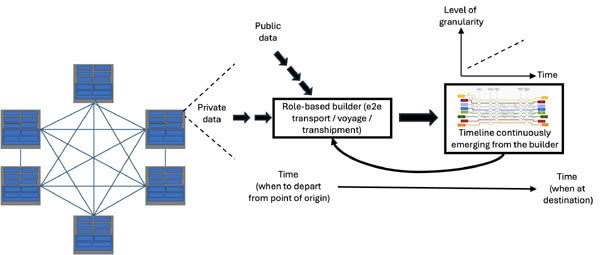VWTnet – Building the Internet of Virtual Watch Towers

[By Mikael Lind, Wolfgang Lehmacher, Sandra Haraldson, Pontus Drejer, Kenneth Lind, Eddie Olsson, Serge Schamschula, Teemu Manderbacka, Xiao Feng Yin, and Sascha Westermann]
The world has entered the most volatile and complex era in the history of modern supply chains. This new age requires new tools. Leveraging the latest technology and their deep experience in digitalization and collaboration, RISE, VTT, and A*STAR’s IHPC have launched an innovative initiative, dubbed the virtual watch tower/VWT (www.virtualwatchtower.org). VWT is a cargo owner-driven terminal-centric initiative created to tackle common challenges along corridors and across international supply chain and logistics networks. The VWT is based on the principle of collaboration and digitalization working in symbiosis to create economic and societal capital known as CDES.
VWT fills a gap in cross-industry collaboration by introducing a new framework and approach to initially improve the management of disruptions and the accuracy of estimated time of arrival (ETA) and carbon dioxide (CO2e) emission calculations. Additional use cases are considered. VWT comprises of first the VWT Community, a group of actors in the supply chain ecosystem, and second VWTnet, a digital solution applied on host/member level enabling data exchanges between different VWT Community member VWTs, which we also call Towers that offer beyond data sharing features a minimalist set of analytics and collaboration capabilities.
VWTnet, which can be understood as the internet of virtual watch towers has structural and functional similarities with the traditional internet and the physical internet, the latter exploits the digital internet metaphor to develop a physical internet vison. According to Benoit Montreuil, who leads the International Physical Internet Initiative, the physical internet is a “Hyperconnected global logistics system enabling seamless open asset sharing and flow consolidation through standardized encapsulation, modularization, protocols and interfaces”.
This article describes VWTnet as the internet of VWTs, drawing parallels with the traditional internet. It illustrates VWTnet’s distributed and self-organizing nature of this system-of-systems that empowers the participating users, such as cargo owners, carriers, and terminal operators. VWTnet isn't just a technological feat; it's a paradigm shift in digital networking. With VWTnet, users can continue to enjoy their individual networks while benefiting from additional features and services brought about by a scalable global peer-to-peer network of VWTs/Towers with high levels of security and efficiency. VWTnet is not just setting a new standard; it's redefining the possibilities of digital networks.
The traditional internet
The Internet is a global connected network system of interconnected computers and devices, traditionally called hosts, that facilitates communication, data sharing, data services, and collaboration.
The Internet’s infrastructure is leveraged by the World Wide Web/WWW to provide digital devices and applications with access to websites. The foundation of the internet is built on a protocol called IP (Internet Protocol) which is a set of rules that govern how data is transmitted across networks and between users. Every computer or device that is connected to the internet is assigned a unique IP address which serves as its virtual identifier.
While the Internet appears to be a single, cohesive construct, it's actually a complex network of individual networks. The user experience is one of a unified platform. This seamless experience is enabled by a robust framework of standards and protocols working behind the scenes.
The combined knowledge of the internet is enormous and continuously growing. Bots, called web crawlers, aim at learning what every website on the internet is about. They automatically access websites and extract data via software.
VWTnet - orchestrator between virtual watch towers
As per its name, VWTnet is a network of VWTs or Towers operated by VWT Community members. VWTnet is a network of networks, allowing individual Towers to exchange and analyze data and collaborate across the federated peer-to-peer network. The Towers can be compared with a node or websites on the internet. There is nothing more that constitutes VWTnet than these individual VWTs able to communicate with each other; no central component is contemplated. While VWTnet has many functional similarities with the traditional internet, there are also differences. E.g., VWTnet has no bots that draw information from individual Towers.
VWTs/Towers can be any kind of software, including off-the-shelf freight management offers and platforms, or in-house and externally developed tailored solutions. What connects them is not a link but the ability to exchange information through protocols and standards. VWTnet might offer a minimalistic (open source) Tower for smaller actors along the chain. Technology providers can build on the Towers, adding additional capabilities. Different maps and analytics might be used, and additional third-party data sources may complement the existing data streams. User front ends may or may not differ. This constitutes the self-organizing nature of the network.
The VWT Community members can exchange data and collaborate via their VWTs/Towers which, in aggregate, constitute the distributed solution VWTnet. Based on pre-agreed parameters, VWT organizes the routing of information, which alters with the changes of actors involved in the different transports. The set of features and services provided by VWTnet includes data sharing capabilities between VWT Community members, public data feeds, services for specific use cases like ETA and CO2e emission calculations, as well as popup situation rooms supported by collaboration features.
Instead of building a central engine and infrastructure, the VWT leverages the VWT Community members’ infrastructures and servers. Members can continue to enjoy the interfaces and experience they are used to, while benefiting from the VWT features and services that enhance the members’ data pools and digital capabilities. VWTnet determines the rules, e.g., standards and protocols that enable users to benefit from it, provided they accept them and comply with them within their own environment.
This design of VWTnet ensures data sovereignty. Data stays with the individual members. Only authorized minimalist datasets are shared with predetermined parties. In crisis situations more data may be made available by data owners to raise the understanding of a situation and support decision-making. The set of services offered by VWTnet follows the minimalist principle as well. This lean approach to the distributed network drives scalability, security, and efficiency.
Distributed network: virtual watch towers of VWTnet
The VWTs/Towers facilitate service access, data sharing, intelligence gathering, and collaborative efforts (Figure 1).

Figure 1: VWT vision of design
Through their Towers, VWT Community members can send and receive timestamps, access public data and data services to broaden their situational awareness and enhance their analytical capabilities. Members’ data sets are enhanced through adding agreed shared private and accessing public data feeding the VWTnet proprietary services or individual members’ applications. The members’ VWTs/Towers generate timelines specific to the cargo monitored, which allows them to calculate ETAs and CO2e emissions. Identified deviations from plans trigger indicators and alerts.

Figure 2: VWT architecture – role-based Builders of holistic conception
The role of an actor, be it cargo owner, terminal operator, or carrier determines the functionalities of the VWTs in VWTnet. An example is the Builders. Towers are equipped with Builders to aggregate actor/role-specific views of timestamps. Cargo owners run e2e (end-to-end) transport Builders, terminal operator transshipment Builders, and carriers voyage Builders (Figure 2).
Each Builder aggregates timestamps, from the member’s/user’s own system or those shared by other members. Enriched by public data, such information raises situational awareness and improves the accuracy of members’ analyses and calculations. An e2e transport Builder for example incrementally builds the itinerary/vision of a specific transport/logistics chain. Each additional data point enlarges horizons and increases the granularity of analysis.

Figure 3: The internet of Virtual Watch Towers empowered by role-based Builders
The functionalities of these Builders vary by the roles of the different VWT Community members/actors along the transport chain (Figure 3)
- Cargo Owners: they operate end-to-end (e2e) transport Builders, which focus on creating a dynamic vision of specific transport and logistics chains.
- Terminal Operators: they employ transshipment Builders, designed to optimize, and sequentially arrange terminal usage.
- Carriers: they use voyage Builders to incrementally develop the schedule and event record for individual voyages or transports.
Revisiting the parallels with the traditional internet, Builders can be seen as web browsers. Just as completely different web browsers can show the same content consistently, VWTs can visualize shared timestamps, as long as they conform to the standards of how to show the data.
VWTs are much more than just operational tools; they are dynamic platforms that not only decentralize control but also enhance, among other things transparency, and efficiency across the entire network. Yet, it's not only about running a network; it's about revolutionizing logistics, transportation, and supply chain management in the 21st century.
The value of VWTnet
VWT Community members share minimalistic datasets, like container identifications (IDs) and limited related timestamps and information that allows to calculate the CO2e emissions. This allows the members, e.g., to identify potential bottlenecks and disruptions early on, and improve the accuracy of predictions of ETAs, and calculations of CO2e emissions for a specific transport.
VWTnet also allows for establishing a database of historic records created from members, shared private and public data, all stored on host level.
VWTnet digests data coming from the various sources cleansed by a specific module operated by the VWT. This ensures quality and reliability of timestamps, CO2e calculation data, as well as ETA and milestone information.
VWT enhances value through complementing existing solutions and data feeds with primary data and state-of-the-art data validation and cleansing capabilities, making VWT a unique and complementary high-quality data feed and partner.
Thanks to VWTnet, cargo owners can develop more accurate visions of their multiple transports, carriers can obtain a holistic view of cargo from multiple cargo owners, while terminal operators can get broader perspectives on the needs of multiple cargo owners and multiple visiting carriers. VWTnet, with the data, e.g., timestamps or CO2e calculations shared between Towers empowers the VWT Community members to co-create economic and societal capital.
VWT: a new model for federated decentralization
The traditional Internet has evolved from an initially privately coordinated space to a multistakeholder model of governance. This decentralized model relies on protocols and standards to govern its vast ecosystem, ensuring that problems can be addressed, and solutions implemented at the most local level possible. This community-driven approach to managing the Internet has been a catalyst for unprecedented growth and innovation.
Building upon these principles, VWTnet adopts a similarly decentralized governance structure. Operations are largely conducted at the host/VWT Community member level, on individual devices and individual networks, under the members’ aegis. The Transport Collaboration Message Format (TCMF) is part of the initial "rulebook". During the prototyping phase, TCMF sets the requirements for data streaming and the minimalist datasets that will be shared among the Towers. Existing standards will be reviewed and tailored to meet TCMF's specific needs or integrated in some other way.
VWTnet maintains a comprehensive, distributed registry of all VWTs. Also, they contain all available APIs. This registry is vital for ensuring the efficient routing and flow of data across the internet of VWTs. It may sit on all Towers being constantly updated.
The governance of VWTnet is vested in an impartial, inclusive, membership-based entity. This entity that will carry and further the VWT needs to be backed by neutral institutions, like the three research institutes RISE, VTT, and A*STAR. This emphasizes the distributed and inclusive nature of the network as a public good. Distinguishing it from commercial solutions like the former Tradelens.
Simplicity: a cornerstone to success
Given the complexity and significance of creating a universally adopted global VWTnet, simplicity is a cornerstone principle. The minimalist approach manifests itself in multiple ways:
- Architecture: VWTnet leverages existing digital infrastructures with a prime focus on network not on nodes, offering only a minimalist Tower to those in need.
- Private data sharing: only essential private data streams and datasets are required to be shared to feed VWT services.
- Public data and services: these can be accessed through APIs, minimizing redundancy.
- Analytical services and tools: VWTnet aims to avoid duplicating existing offerings, focusing instead on complementary data, and minimalist proprietary features and services.
- Entity: a lean neutral entity will operate and further the VWT.
- Governance: a small set of agile rules ensures that VWTnet can swiftly adapt to changing and evolving needs.
- Onboarding: a simplified onboarding procedure for new members supports trust and allows to scale the network quickly.
By embracing a minimalist strategy across these facets, VWTnet aims to streamline its operations, thus facilitating easier consensus-building and reducing resistance to its adoption. In doing so, VWTnet not only mirrors the successful governance model of the traditional internet but also sets a new standard for decentralized, community-driven logistics networks.
Conclusion
VWTnet is distributed in nature to ensure adoption, scalability, efficiency, effectiveness, and data sovereignty. The solution is lean and governed by simple rules. No single power controls the VWTnet. Essentially, VWTs role is focused on empowering individual member Towers to exchange data and collaborate across the network allowing VWT Community members to improve their operations.
Our aim is to replicate the success of the traditional internet. The original internet had a slow start but eventually took off and boosted innovation and economic growth across the world. We call upon actors of the supply chain and logistics ecosystem to join the effort to co-create the internet of VWTs as a public good to upgrade supply chain management and collaboration capabilities in supply chain networks across the globe.
Acknowledgement
We are also grateful for the comments of Henrik Hvid Jensen (DXC Technology), Brian Laung Aoaeh (Refashiond ventures), Henk Mulder (IATA), and Phanthian Zuesongdham (Hamburg Port Authority) on the distributed network approach elaborated on in this article.
About the authors
Mikael Lind is world’s first (adjunct) Professor of Maritime Informatics engaged at Chalmers, and Research Institutes of Sweden (RISE). He is an expert contributor at World Economic Forum, Europe’s Digital Transport Logistic Forum (DTLF), and UN/CEFACT. He is co-editor of the first two books on Maritime Informatics, and is co-author of Practical Playbook for Maritime Decarbonisation and co-editor of the book Maritime Decarbonization.
Wolfgang Lehmacher is partner at Anchor Group and advisor at Topan AG. The former director at the World Economic Forum, and CEO Emeritus of GeoPost Intercontinental, is an advisory board member of The Logistics and Supply Chain Management Society, ambassador F&L, advisor GlobalSF, and member of the think tanks Logistikweisen and NEXST.
Sandra Haraldson is Senior Researcher at Research Institutes of Sweden (RISE) and has driven several initiatives on digital collaboration, multi-business innovation, and sustainable transport hubs, such as the concept of Collaborative Decision Making (e.g. PortCDM, RailwayCDM, RRTCDM) enabling parties in transport ecosystems to become coordinated and synchronised by digital data sharing.
Pontus Drejer is a research engineer at Research Institutes of Sweden (RISE) who has worked hands-on with building demonstrators for CDM projects since 2017. He holds a BSc in computer science from the University of Gothenburg and has several years of both industry and research experience building software.
Kenneth Lind is Senior Researcher at Research Institutes of Sweden (RISE) and has driven several research projects focusing on system architecture and software engineering challenges in the automotive and transport sector. He holds a PhD in software engineering from Chalmers University of Technology and has 20 years of industrial experience as technical leader.
Eddie Olsson is a senior research engineer at Research Institutes of Sweden (RISE) with almost a decade of experience from developing data distribution and demonstrator platforms supporting the CDM concept.
Serge Schamschula is Head of Ecoystem at Transporeon a Trimble company, Vice Chair in ALICE (Alliance for Logistics Innovation through Collaboration in Europe) as well as Expert Evaluator for the European Commission. He has 25 years of experience in logistics and supply chain systems.
Teemu Manderbacka is Sustainable Shipping Research Team Leader at VTT. He contributes to Safe and Energy Efficient Maritime Transportation through technological improvements. He has strong background in Naval Architecture; hydrodynamics numerical methods, experimental research, and software services to ship owners and operators to improve ship technical performance and energy efficiency.
Xiao Feng Yin is a senior research scientist of Institute of High Performance Computing, Agency for Science, Technology and Research (A*STAR) of Singapore. He has led various grants and industry projects in the areas of maritime study, logistics and supply chain. He received both his Master and PhD degrees from Nanyang Technological University (NTU), Singapore.
Sascha Westermann is Senior Business Consultant at Fujitsu Germany GmbH. With many years of experience in the areas of ports, logistics and mobility from the authorities' perspective, he supports the development of services that offer immediate added value in the spirit of Fujitsu Uvance - Trusted Society
The opinions expressed herein are the author's and not necessarily those of The Maritime Executive.

